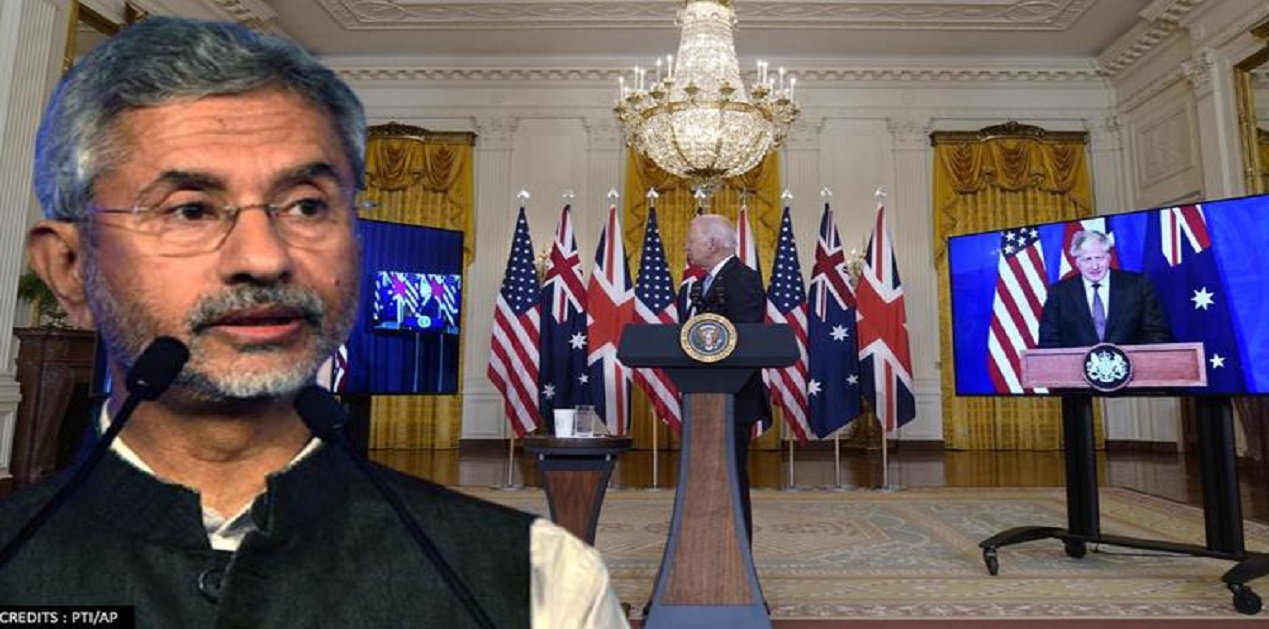2021 was an eventful year in the Indo-Pacific region. Several developments have taken place, which are significant in their own right, but are rather indicative of what lies ahead in this region. This article examines the implications of the key security developments of 2021 and how these have set the tone for the future of Indo-Pacific security. Some possibilities in 2022 and in the near future are also presented in this article.
Biden’s Approach to the Indo-Pacific
This year was the first year of the Biden presidency. Until he took office, Biden’s policy on the Indo-Pacific was obfuscated. Regionally there were apprehensions whether Biden will maintain erstwhile assertive approach towards China, or will he adopt policies to arrive at a modus-vivendi. One year later, the US approach to the region is clear. As expected, Biden, on the face of it; showed that it is invested in Indo-Pacific. His administration made visits into the Indo-Pacific, and specifically in Southeast Asia to assure US allies and partners. However, largely the Biden administration is essentially continuing Donald Trump’s policy, albeit with some sophistication and subtlety. Trump had communicated, in no uncertain terms that the allies and partners need to share the burden. This had caused discomfort in American allies in Asia. But Biden’s approach so far seems to toe a similar line. Until now, the US has not made any mega security pact or plan for the region that is exclusively its own. However, the Department of Defense, has allocated USD 66 billion for the Indo-Pacific region[1]. The Pacific Deterrence Initiative, (PDI) a subset of the defence budget has been allocated USD 5.1 billion. The objectives of the PDI are to develop ‘advanced, asymmetrical capabilities and capacities designed to operate in an anti-access/area denial environment’ of the Indo-Pacific.[2] China has been identified as the principal threat, besides being concerned with stability in the Korean Peninsula.
The Biden administration also made overtures to Southeast Asia. Vice President Kamala Harris and Secretary of Defence Lloyd Austin visited Singapore and Vietnam in August and July respectively. Secretary of State Anthony Blinken visited Indonesia, Thailand and Malaysia in December. Indonesian President Joko Widodo had a bilateral meeting with President Joe Biden. Biden also attended the East Asia Summit and also the US-ASEAN summit. But did Biden administration fulfil the expectations that Southeast Asia has had from the US? As one sees things at present, the US is clearly prioritising security in the Indo-Pacific. The message is that the US will play role in shaping regional security, and it is up to Southeast Asian states to be on board or not[3]. One year later, the US has not promulgated any economic strategy; something that Southeast Asian countries in particular have been demanding. The US, so far, appears under no such pressure to deliver on the economic front. It is playing on its strength as the world’s most powerful military, and this is likely to remain America’s approach to the Indo-Pacific.
A significant defence pact like the AUKUS, initiated by the US has set Australia’s strategic choice in Washington’s favour. The AUKUS has accelerated the downturn in Australia- China relations. It has put Canberra on a certain path for good. The US is likely to initiate or facilitate defence cooperation of various degrees within the Indo-Pacific, thus attempting to bring countries closer to it and wean them away from China’s influence.
AUKUS by its essence and expression is a continuation of former President Trump’s rhetoric of expecting allies to share the burden. The US is sharing with its coveted technology of nuclear-propelled submarines, but the cost is to be borne by Australia and the UK. The recent defence pacts between Australia, Japan and South Korea-all of US’s allies seems to indicate that Biden administration is inclining at a ‘self-help’ principle, where US allies do more amongst themselves, and take up greater responsibility in the region. In the long run, one gets a sense that the US would like to set up regional security architecture on an auto-pilot, the one where minimal US intervention is necessary.
Biden’s emphasis on climate change and his normative stance on democracy is unlikely to find traction where countries are either aspiring for greater economic development, or are not democracies[4]. In the past, it was US’s use of democracy as a stick that laid out the path for grater Chinese penetration. If the Biden administration takes this beyond a threshold in the Indo-Pacific region, it would face local resistance. The alternative is already up and running.
A Test for ASEAN
As a product of the Cold War, the ASEAN managed regional security well, particularly trans-national challenges like piracy, other sea-based threats and terrorism. The ASEAN in its expanded form succeeded in maintaining a stable external environment. This was conducive for national economic growth and prosperity. But the last decade has been challenging and apparently there has been a lack of corrective/effective measures. The South China Sea divided the region, and this time over the Myanmar crisis. The Myanmar issue has not been divisive in the way maritime conflicts were for ASEAN, but it has put its conflict resolution abilities to test. ASEAN members have demanded to be at the centre of regional security management, having faith in its institutions (and thus being unwelcoming to initiatives like the Quad). But the inability to manage the Myanmar crisis has brought its limitations out in the open. This year when Cambodia takes the chairmanship, the organisation is likely to witness challenges. It is likely that under Cambodia’s chairmanship, there could be a pragmatic outreach to the Tatmadaw[5]. In the past year, ASEAN’s policy had been to engage with Myanmar, through any high-level leader but Min Aung Hlaing. However, in the China-ASEAN summit, Myanmar was not represented. This happened because while China desired Min Aung Hlaing to participate, ASEAN had strongly objected and instead sought any other nomination[6]. Perhaps for the first time, ASEAN members took a strong normative stance against one of their own. ASEAN’s policy of consensus, consultation and non-interference was always criticised as its limitation to resolve regional security crisis. This time, the organisation seems to have somewhat departed from the non-interference principle; it is to be seen whether this continues, or the group reconciles to the reality. If the members are polarised over Myanmar, then a repeat of the 2012 developments-coincidently when Cambodia was the chair; are very likely. Will ASEAN risk its cohesion over Myanmar?
ASEAN members are seen to follow their national interest evinced by their external engagements. Vietnam has advanced its relations with the US; Indonesia has recently articulated its maritime interests in the Natuna and a closer security relationship with the US is plausible. The Philippines has not abrogated the Visiting Forces Agreement[7], much to Washington’s relief, but it has neither moved ahead to implement the 2014 Enhanced Defense Cooperation Agreement[8]. Thailand, the longstanding US ally, has over the time diverged from its strategic goals with the US, it has turned more authoritarian and its elites desire closer ties with Beijing[9]. Cambodia and Laos are already close to China.
The region is not out of the Covid pandemic yet, so battling the pandemic and restoring economic growth is going to be the priority for Southeast Asia. So, the dependency on China will be unquestionable. China has provided covid assistance to Southeast Asia in the form of aid and vaccines. In the absence of an economic alternative, the region will not compromise on its ties with China. That said, Indonesia in particular and Vietnam to an extent will see challenges to balance its relations with the two great powers. Indonesia is thus likely to seek wider engagement with other powers. But if one has to predict the region for the rest of 2022, dealing with the pandemic will be the first priority. Few years hence, Southeast Asia’s worst fear-of having to choose sides (albeit not straightforward and blatantly) might come true.
A Return of the Anglo-Saxon Order?
In the last two years, Europe has shown interest in the Indo-Pacific. The United Kingdom, France, Germany and Netherlands- all of them published respective Indo-Pacific strategy documents. The EU as an organisation also came out with its Indo-Pacific policy. The common theme amongst these strategies is an interest in the security of the Indo-Pacific, by justifying their interests on the basis of trade & economic interests, or climate change or human security and non-traditional threats. Security and stability of the Indo-Pacific is connected to their national security, thus projecting themselves as legitimate stakeholders in this region. Now, as a region with dwindling population and ageing demography the European countries have economic interests in the Indo-Pacific. Indo-Pacific is home to several emerging and large economies; hence European business interests are natural. There is however also a strong interest in regional security. The question is-what does Europe bring to the table militarily? Most of them have limited defence budgets and force levels. The UK for instance, is now beginning to expand its navy after its exit from the EU. France of course has territories and military presence across the Indo-Pacific. A critical analysis of European interest in Asia points to two objectives-one, to ‘be there’ while the Asian security landscape is shaping up and try to influence it suitably. It is a fact that in the Indo-Pacific, the US, Japan, India and China and Russia are the influential players. In a hypothetical situation, China and India could shape the regional order, which may or may not be in the interest of these European nations. Engagement with resident powers and articulating national interests in the Indo-Pacific gives European nations an entry to the Asian landscape. The second interest is defence sales, and exploring newer markets.
The British, German and French naval ships undertook FONOPS in the South China Sea. A cynical perspective would observe these as activities to remain relevant when the centre of economic and strategic gravity has shifted from Atlantic to the Indo-Pacific. But the regional scepticism[10] came to fore after the AUKUS was announced. AUKUS of course came as a huge surprise (or shock) to everyone and several analytical pieces have been since published. It is a military initiative in the context of China’s A2/AD and missile defences. It greatly elevates Australia’s position. This is of course, US changing the balance of power with its two formidable allies. In vacuum, the pact should not raise any eyebrows. But the cancellation of Australia-France submarine deal, the underlying UK-France competition and the secrecy appears like a replication of medieval times when European powers competed in Asian waters. This hypothesis may sound exaggerated to some, yet it cannot be ruled out, given how history repeats itself, even more so on the oceans. If one proceeds with this scenario, then it reduces agency of regional countries in shaping their destiny.
Russia Enters Southeast Asia
This year, Russia and Southeast Asia conducted its first-ever naval exercise. Russian naval ships interacted with naval assets from Indonesia, Malaysia, Brunei, Thailand, Vietnam and Singapore with the aim of building inter-operability[11]. This is a significant development and indicative of ASEAN members’ deftness at external balancing. Russian involvement in Southeast Asian landscape could have three outcomes: one, a multipolar contest in Southeast Asia, or a bi-polar landscape with Russia and China teaming up against the US, or a third where Russia acts independent of China, and coordinates with India. Russian maritime interest and India’s Indo-Pacific leg of Chennai-Vladivostok corridor could alter power configurations in East Asia.
2022 for India in the Indo-Pacific
Nearly two years later, the Galwan crisis offers several explanations. At the face of it, it seemed like the Chinese reacting strongly against a closer US-India relationship or against the Quad. But it could have also been in anticipation of US withdrawal from Afghanistan, lest it bring instability at China’s doorstep. It might also be that China is resetting configurations by shifting conflict on the land where it has strength, and in the same breath, containing India’s maritime focus. Whatever may be the Chinese goal, the fact remains that Indian strategic calculation has changed, where China has become another adversary like Pakistan for India. The forces are split and this means greater defence expenditure. A hot continental border could reduce the pace of naval build-up. India has handled the crisis well; the force did not buckle even in unliveable Ladakh winters. But this changes rules of engagement in the northern and eastern sector. The two-front war scenario is no more distant. Besides, China would try to checkmate India by non-kinetic means as well.
China’s engagement in India’s neighbourhood will be a source of worry. China’s recent activities in Maldives run the fear of a déjà-vu. When China’s border law comes into effect, what would be India’s action? Similarly, the situation in Afghanistan and, Myanmar in particular will impact national security,
The AUKUS was seen by some in India as a reflection of limits of New Delhi, or that a major security pact was made without India, as a Quad member. The fact is that India would have not agreed to such an advanced cooperation since it would compromise its principle of strategic autonomy. India is thus not seen as part of an overt anti-China coalition. India has maintained that the Quad is distinct from AUKUS and that it has no impact on the Quad. [12] As far as the Quad is concerned, it will remain focussed on larger systemic issues like space and cyber, digital technologies, and the military focus so to say, will be in the maritime domain. Hence, no major change is anticipated in 2022.
The Indo-Pacific region and specifically Southeast Asia is going to be polarised in the near future. The trends to this end were visible through US-China competition to influence Southeast Asia in 2021 and in early 2022. Indian policymakers would like to explore options in and implications of a divided Southeast Asia. Southeast Asia, and the wider Indo-Pacific region is going to be tense and signs of instability are visible. Indian policymakers would have to factor in their options in a scenario of an unstable and polarised Indo-Pacific. India has already teamed up with Russia to export the BrahMos to the Philippines. What should be India’s objectives and means, amidst US-China competition, should a favourable environment emerge in Southeast Asia? Should India become vocal about the South China Sea?
Endnotes :
[1] ‘Pacific Deterrence Initiative’, Office of the Under-Secretary of Defense, DoD fiscal budget 2022,May 2021
[2]Ibid, pp 1.
[3] ‘Takeaways from the Fullerton Lecture’, Vivekananda International Foundation, 19 August 2021. https://www.vifindia.org/2021/august/19/takeaways-from-the-fullerton-lecture
[4]Or are not democratic enough from Biden’s perspective, for example Bangladesh that were not invited to the Democracy Summit
[5]Strangio, Sebastian, ‘Uncertainty, Criticism Ahead of Hun Sen’s Myanmar Visit,’ The Diplomat, 6 January 2022. https://thediplomat.com/2022/01/uncertainty-criticism-ahead-of-hun-sens-myanmar-visit/. Also, at the time of publication of this article, Hun Sen met up with Min Aung Hlaing in bilateral capacity. [6]Nachemson, Andrew, ‘China-ASEAN summit begins without a Myanmar representative’, AL Jazeera, 22 November 2021. https://www.aljazeera.com/news/2021/11/22/china-asean-summit-begins-without-a-myanmar-representative
[7]Polling, Gregory, ‘Austin Accomplishes Two Missions in Southeast Asia’, CSIS, 30 July 2021https://www.csis.org/analysis/austin-accomplishes-two-missions-southeast-asia[8]Patton, Susannah, ‘Kamala Harris’s Asia Trip Can’t FixBiden’s Troubled Indo-Pacific Strategy’, Foreign Policy, 24 August 2021. https://foreignpolicy.com/2021/08/24/kamala-harris-singapore-vietnam-southeast-asia-trip-biden-indo-pacific-strategy/
[9]Abuza, Zachary, ‘Americashouldberealisticaboutitsalliance with Thailand’, War on the Rocks, 2 January 2020 https://warontherocks.com/2020/01/america-should-be-realistic-about-its-alliance-with-thailand/
[10]Wang, Paul, ‘AUKUS aims to perpetuate the Anglo-Saxon supremacy’, Modern Diplomacy, 23 September 2021. https://moderndiplomacy.eu/2021/09/23/aukus-aims-to-perpetuate-the-anglo-saxon-supremacy/
And
Geiger, Jeffery, ‘AUKUS: Recalling Legacies of Anglo-Saxonism and Muffling the Voices of Island Nations’, E-International Relations, https://www.e-ir.info/2021/09/25/aukus-recalling-legacies-of-anglo-saxonism-and-muffling-the-voices-of-island-nations/
And
Muhammad, Mahmood, ‘AUKUS: a new Anglo military alliance ‘, The Financial Express, 2 October 2021 https://www.thefinancialexpress.com.bd/views/views/aukus-a-new-anglo-military-alliance-1633186200
[11] ‘Russia, Southeast Asia conclude first joint naval exercise’, Reuters, 4 December 2021 https://www.reuters.com/world/asia-pacific/russia-southeast-asia-conclude-first-joint-naval-exercise-2021-12-04/
[12]AUKUS Has No Relevance to Quad, Nor Will it Impact its Functioning: India’, The Wire, 12 September 2021. https://thewire.in/diplomacy/india-aukus-quad-harsh-vardhan-shringla
(The paper is the author’s individual scholastic articulation. The author certifies that the article/paper is original in content, unpublished and it has not been submitted for publication/web upload elsewhere, and that the facts and figures quoted are duly referenced, as needed, and are believed to be correct). (The paper does not necessarily represent the organisational stance... More >>
Image Source: https://img.republicworld.com/republic-prod/stories/promolarge/xhdpi/175faadoenpckgzt_1631809800.jpeg











Post new comment